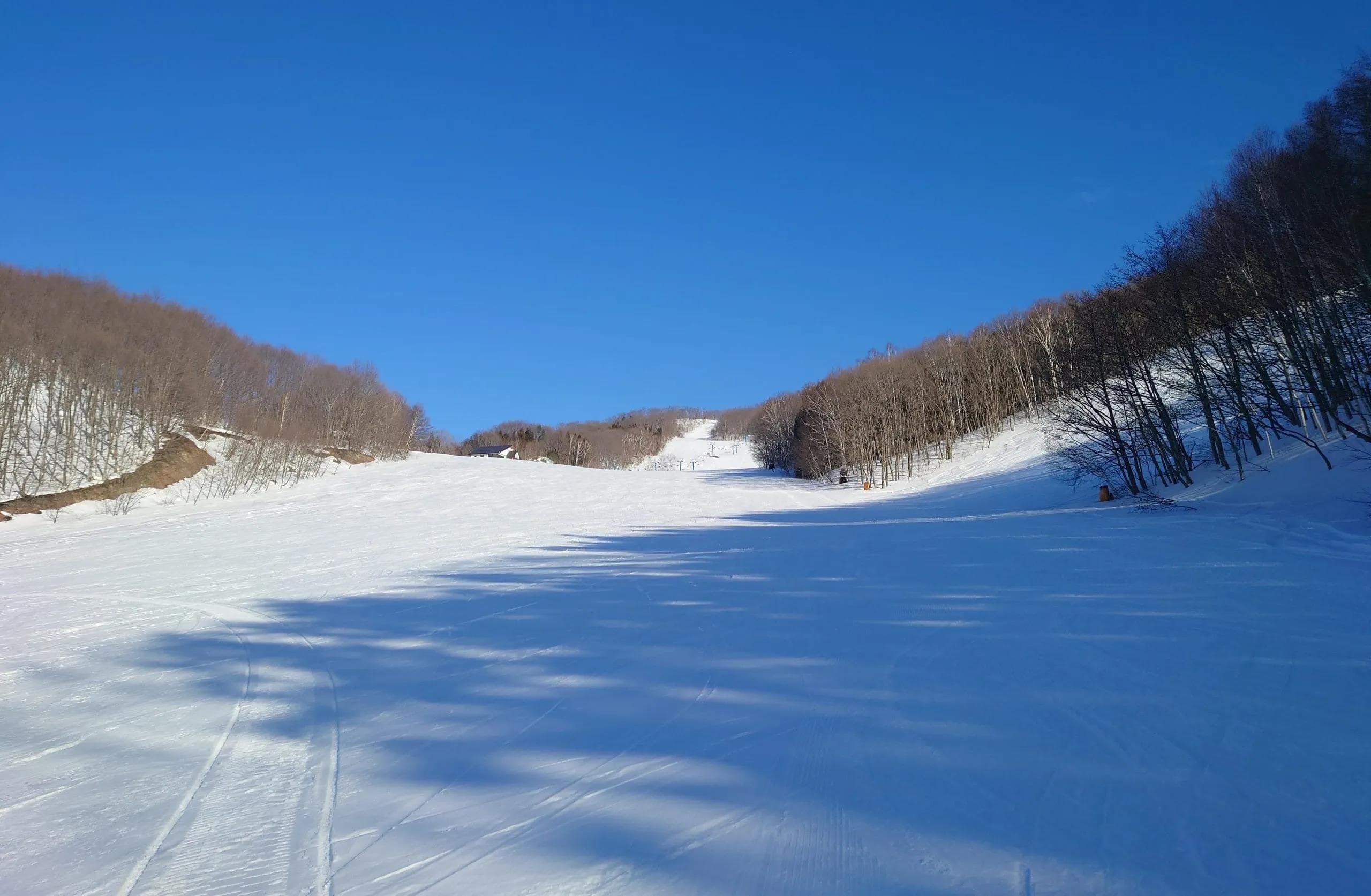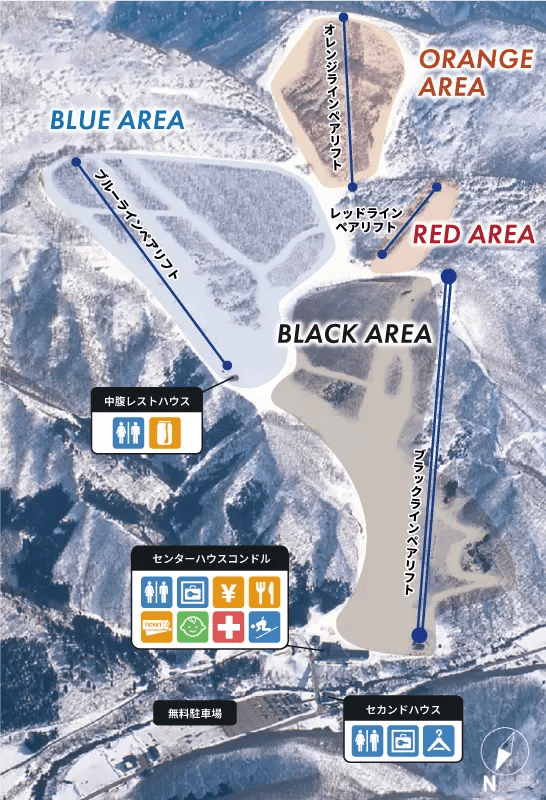Kita Nikko Takahata
Steep groomers, cold storms, local soul

高畑
Kita Nikko Takahata
8.4~8m
Snowfall
1240m
Elevation
5
Lifts
$31
Price
Aizu highland rhythm — low-key, cold, and kind to carve.
Kita Nikko Takahata is the kind of place that rewards riders who value snow feel over scene. Tucked deep in Minamiaizu, it sits far enough inland to dodge the worst of warm spells and hold quality well after a storm. The lines are honest — fall-line groomers with bite — and the mood is classic rural Tohoku: welcoming staff, mellow lifties, and a carpark full of die-hard locals tuning edges in the morning alpenglow. English isn’t widely spoken, but a smile and a few phrases go a long way.
Weekdays can feel like a private hill, which is why many Aizu powder chasers time their visits between systems to harvest wind buff, chalk, and boot-top refreshes. Weekends bring a touch more energy — race clubs, families, and local crews — yet even then the longest waits are usually just a couple of chairs. There’s no gondy, no high-speed quads, and no noisy village — and that’s the charm.
Affordability is a big part of the appeal. Lift tickets sit well below big-name resorts, parking’s straightforward, and the base lodge serves hearty fuel without gouging. Pensions and minshuku nearby are simple and warm; if you’re here to rack first chair and sneak in a last chair groomer, you won’t miss the nightlife you never came for.
Families do fine here thanks to broad, confidence-building groomers lower on the hill and an easy base setup. The more advanced among you will spend time on the steeper lines off the upper chairs, working the fall line for edge-to-edge trenching when it’s chalky and ducking onto the in-bounds ungroomed strips after a reset. Respect the ropes — there’s no formal gate system — and you’ll have a great, low-drama day.
Resort Stats
- Vertical520m (1240m → 720m)
- Snowfall~8m
- Terrain 30% 50% 20%
- Tree Riding
- Lift Pass$31
- Lifts4 pair, 1 schlep
- Crowds
- Out of Boundsnot allowed
- Night Skiing
- Family Friendly
- Trails10
- Skiable Area~60ha
- VibeAizu core locals, steep-groomer culture
Trail Map

Powder & Terrain
Kita Nikko Takahata skis bigger than the map suggests, but by design it’s a local’s hill — expect clean fall-line groomers with a couple of in-bounds ungroomed lanes that hold soft snow after a reset. Ride Black for the steeper pitches and carving hero snow, swing to Blue for long, confidence-building arcs, and use Orange when there’s new snow to sample designated soft strips. Boundary rules are strict — no gate network and no sidecountry access — so keep it in-bounds and mine the edges and rollers for secret stash pockets. With light traffic, storm-day butter sticks around and the surface stays chalky between systems.
Who's it for?
Advanced carvers, ex-racers, and anyone who loves the feel of a clean fall line will be at home here. If you get more joy from trenching corduroy, hunting wind buff, and linking long arcs than from chasing airtime, you’ll click with Takahata. Upper intermediates can build confidence quickly — the grooming is consistent and the pitches are honest without surprises. Tree hunters and gate-system explorers will find the offering limited; park rats looking for big features and those craving nightlife should point elsewhere or pair this with a bigger Aizu resort.
Accommodation
The closest stays are classic Aizu pensions and minshuku dotted along the valleys — simple rooms, warm ofuro, home-style dinners, and early breakfasts that get you out the door for first chair. This is where you’ll swap storm stories with local regulars and watch spindrift feathers dance under the lodge lights before bed. Expect friendly hosts, shared common rooms, and a quiet, early-to-rise rhythm.
If you prefer a bit more anonymity, look to business hotels closer to Aizu-Tajima or along the arterial roads toward the Kanto side. These are pragmatic bases with late check-in, firm beds, and onsite coin-laundry — perfect if you’re chasing a moving snow line around Fukushima and Tochigi. You won’t find buzzy nightlife, but you will find convenience stores, late ramen, and the freedom to dawn patrol without waking a house full of guests.
For a treat, book a night at a small onsen ryokan within a short drive. The region is laced with sulfur-tinged baths and cedar-lined rotenburo that reset tired legs in winter silence. Nothing beats soaking under a cold sky after a day of first chair to last chair carving, then tucking into a kaiseki spread heavy on mountain vegetables and river fish.
Food & Après
On-mountain, expect the classics done right: curry rice, tonkatsu, steaming bowls of ramen, and trays of karaage with crisp skin. Portions are worker-sized and the prices won’t sting. Coffee is basic but hot, and there’s always a local dessert or two on the counter.
Off the hill, nearby eateries keep it simple and satisfying. Aizu staples like ソースカツ丼 (sauce katsu-don), そば (hand-cut soba), and hearty mountain vegetable dishes are easy wins on cold nights. If you’re passing through Aizu-Wakamatsu on the wider trip, add 会津郷土料理 like こづゆ (light scallop-based soup) to your list. Après is mellow — more lot beers in the carpark at sunset than bar crawls — but the stoke runs deep when it’s been nuking.
Getting There
The cleanest drive from the Kanto side is via the Tohoku Expressway to 西那須野塩原 IC, then a long, scenic run on National Routes toward Minamiaizu. In clear conditions, budget around 3.5–4.5 hours from central Tokyo depending on traffic and road surface. In storms, those last valleys fill with spindrift and visibility can drop quickly — winter tires are non-negotiable and chains are smart insurance.
Public transit works if you’re patient: ride Tobu/Aizu Railway to 会津田島 (Aizu-Tajima), then connect by local bus into the hills. Services are limited, especially midweek, so set your schedule around the bus rather than the other way round. If you’re stringing together an Aizu tour — Takatsue, Daikura, Minamiaizu Nango — a rental car keeps your powder options open.
Japow Travel Tips
- Lift hours: Typically 08:30–16:00 in winter; no night skiing. Arrive early for rock-solid first chair plans.
- Operations pattern: Some upper lines may alternate operating days outside peak periods. Check the daily board at the base before you set your plan.
- Snowboard access: Historically ski-only; now open to snowboards. Etiquette is friendly — keep merges tidy and bar down.
- Avalanche / backcountry: No gate network and no sanctioned sidecountry. Ducking ropes is a no-go; patrol may pull your pass.
- Weather: Interior exposure means colder temps than coastal Honshu — surfaces hold chalk and wind buff well between storms.
- Language & payments: Limited English; carry cash for small eateries and pensions though the ticket window may accept cards.
- Pairing options: String this with Takatsue, Daikura, and Nango. On higher-snow cycles, consider a day at Grandeco or Nekoma Mountain for more tree options.
Verdict: The fall-line faithful’s Aizu hideaway
Kita Nikko Takahata is proof that you don’t need mega infrastructure to have mega days. It’s a place where cold storms reset the canvas, groomers run true, and the locals’ etiquette keeps everything flowing. Come for trenching on crisp mornings, linger for soft-edge afternoons when the wind lines and ungroomed strips deliver free refills, and enjoy the simple pleasure of a hill that’s been quietly doing it right for decades — no hype, just good snow and better skiing.